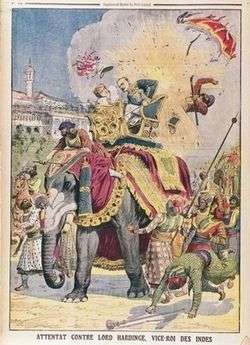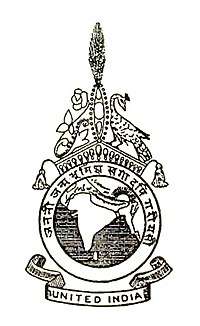Basanta Kumar Biswas
Basanta Kumar Biswas (6 February 1895 – 11 May 1915) was an Indian pro-independence activist involved in the Jugantar group who, in December 1912, is believed to have bombed the Viceroy's Parade in what came to be known as the Delhi-Lahore Conspiracy. He was initiated into revolutionary movement by Jugantar leaders Amarendranath Chattopadhyaya and Rash Behari Bose.
Basanta Kumar Biswas | |
|---|---|
File photo of Basanta Kumar Biswas | |
| Born | 6 February 1895 |
| Died | 11 May 1915 (aged 20) Ambala, Punjab, British India |
| Organization | Jugantar |
| Movement | Indian Independence movement |
Early life: 1895-1915
Basanta Kumar Biswas was born on 6 February 1895 at Poragacha in Nadia district of West Bengal, to Matilal and Kunjabala Biswas. He belongs to the family of freedom fighter Digamabar Biswas, an active leader of the Indigo revolt(or Nil Bidroha) and freedom fighter Manmathnath Biswas. He started his schooling at his village and then he moved to M. I. School in nearby village Madhavpur with his cousin Manmathnath Biswas. M. I school was established by social reformer and freedom fighter Gagan Chadra Biswas. In 1906, Basanta was moved to Muragacha school. Khirodh Chandra Ganguly was principal in Muragacha school. Under his guidance Basanta started his journey of freedom fight.[1] Later he was recruited by Rash Behari Bose and trained in arms and bombs.[2] Rash Behari Bose often called him Bishe Das.
Revolutionary activities

On 23 December 1912, Biswas, disguised as a woman, threw a bomb at Lord Charles Hardinge, who was riding with his wife on an elephant during a procession at Chandni Chawak, Delhi.[2] Hardinge escaped with flesh wounds, but the servant behind him holding his parasol was killed.[3] The authors of the deed remained obscure for many months despite the state's intense investigation, and lucrative reward.[4] Biswas was arrested on 26 February 1914 in Poragachha, Nadia while he went to perform the last rites for his father. The trial, which came to be called the Delhi-Lahore Conspiracy Case, began on 23 May 1914 in Delhi, and Basanta was found guilty on 5 October and sentenced to life imprisonment. Three other men were condemned to death at the same trial: Amir Charid, Abadh Behari, and Balmokand.[4]
An appeal was formulated at Lahore High Court. The Crown won its appeal and Biswas was sentenced to be hanged.
Basanta Kumar Biswas was hanged on 11 May 1915 at Ambala Central Jail in Punjab aged twenty and became one of the youngest people to be executed during the Indian revolutionary struggles during the 20th century.
Legacy
There is a statue of Basanta Biswas established by Rasbihari Basu in a park of Tokyo, Japan. Another statue is situated in front of Rabindra Bhawan, Krishnanagar, Nadia.[5] A school in civil lines, Delhi was named "Shaheed Basant Kumar Biswas Sarvodaya Vidhyalaya" in his memory. Although it was later renamed to Rajkiya Pratibha Vikas Vidhyalaya. On the request of Sankariswar Dutta of Gobrapota Subhendu Memorial Seva Pratisthan the Loka Sabha Speaker Meera Kumar has installed a photo of Basanta Kumar at the Museum of the Indian Parliament. Ujjal Biswas, an Indian politician and the present Minister for Technical Education in the Government of West Bengal belongs to the family of Basanta Biswas.[6]
Notes
- [Sahid Basanta Kumar Biswas & Delhi-Lahore Conspiracy Case by Sampad Narayan Dhar and Published by Kalinagar Co-Operative Colony & Credit Society Ltd. on the initiative of Sankariswar Dutta, Tel-09339757442 in Bengali]
- http://www.frontierweekly.com/archive/vol-number/vol/vol-44-2011-12/vol-44-45/cnb-44-45.pdf
- "Archived copy". Archived from the original on 12 March 2007. Retrieved 9 February 2006.CS1 maint: archived copy as title (link)
- "ExecutedToday.com".
- Narayan Sanyal, Editor Sudhir Chakraborty (1973). Basanta Biswas noy, Bishe Das(Bengali). Krishnanagar: Krishnanagar College Magazine, Patrika Parishad.CS1 maint: extra text: authors list (link)
- S Kumar. "Ujjwal Biswas TMC Leader Profile Family Education Career Life & Background Ujjwal Biswas - Kolkata Bengal Information". kolkatabengalinfo.com.
External links
See also
- Indian independence movement
- Indian National Army
- Arzi Hukumate Azad Hind
- Revolutionary movement for Indian independence
